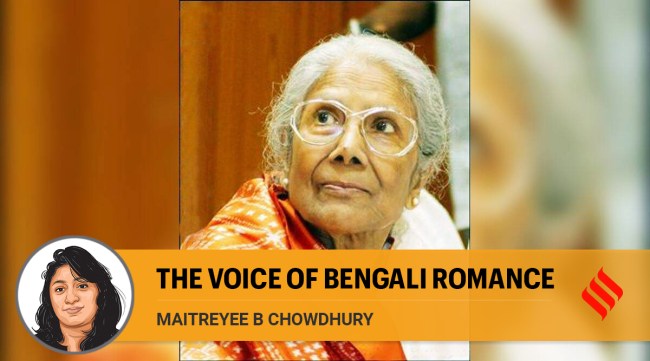Opinion Sandhya Mukherjee’s songs still resonate with Bengal’s young lovers
Maitreyee B Chowdhury writes: She had a special ability to make people dream, to take them to some far-away magical land where they become one with music
 Sandhya Mukherjee (Photo: Facbeook @Sandhya Mukhopadhyay)
Sandhya Mukherjee (Photo: Facbeook @Sandhya Mukhopadhyay) In the early 2000s, I was doing research for my book on Uttam Kumar and Suchitra Sen. As a part of this journey, I not only watched many of the duo’s films but also spoke to people for whom the Uttam-Suchitra films had been a part of their growing years. Almost every one of these people also mentioned the songs in these films, and how important a part they had played in the overall impact of the film. Most of these immensely popular songs had been sung by two famous singers from Bengal, Sandhya Mukherjee and Hemanta Mukherjee.
Sandhya Mukherjee’s career as a singer began when she was a young girl. She started by singing for the radio, during and after which she received extensive training in classical music. Mukherjee’s voice soon became well-known, especially in Bengal, and this resulted in Sachin Dev Burman requesting her to sing for Hindi films. She shifted to Bombay in the 1950s to sing for the Hindi film Tarana, which was released in 1951, and where for the first time she sang with the by-now famous Lata Mangeshkar. The combination of Lata Mangeshkar and Sandhya Mukherjee in the hit song Bol papihe bol led to many more films and songs for Mukherjee. But in spite of having a flourishing career in Hindi playback singing, she opted to return to Bengal to continue her career there.
In Bengal, Mukherjee worked with many filmmakers but, undeniably, her best work happened with Robin Chatterji, who exploited her classical singing skills. A Patiala Gharana singer, Mukherjee brought a unique classical blend to film music. The timbre of her voice was fresh and unlike what audiences had heard before. While Sandhya Mukherjee was a known name, it was her pairing with Hemanta Mukherjee that became most memorable. In film after film, the duo began singing for the romantic hit pairing of Uttam Kumar and Suchitra Sen.
Suchitra Sen on screen became synonymous with Sandhya Mukherjee’s voice. Indeed, many would say they nourished each other’s artistic journeys. Soon it came to be that almost every other film of Sen, with a hit song, had a playback by Mukherjee. Apparently, they even altered their respective voices and mannerisms to suit the other while the songs were filmed. One of the earliest films where she sang playback for Suchitra Sen was Agni Pariksha (1954). The film was a huge hit and took both their careers on an upswing. Songs like Gaane mor kon Indradhonu or Ke tumi amare dako alokhe lukaye thako, became a rage. The songs, which were played again and again in public domains, from coffee shops to puja pandals, catapulted both the star cast and Mukherjee into immense fame. Other songs like the popular Ghum ghum chand jhikimiki tara (Harano Sur, 1957), or the semiclassical Kaun tarha se tum (Uttar Phalguni, 1963) followed one after the other in quick succession, and cemented Mukherjee’s reputation in the Bengali music industry.
In 1961, Sandhya Mukherjee sang Ei poth jodi na sesh hoy, a fun romantic song for the film Saptapadi, along with Hemanta Mukherjee. It was picturised on Uttam Kumar and Suchitra Sen, a song about lovers taking off on a journey of togetherness. The song caught the imagination of the youth of the time and went on to gain cult status, eventually becoming one of Bengali cinema’s most loved and iconic songs, hummed till date, and still known to resonate with young lovers. An octogenarian I had interviewed for my book spoke about the songs laughingly, “Suchitra Sen and Uttam Kumar with their good looks, and the voice of Sandhya Mukherjee and Hemanta — can you imagine what a potent combination it was? It was sublime, we fell in love!”
To her credit, Mukherjee’s career wasn’t limited to film music. She never let her training in classical music go to waste. She continued to perform in classical music soirées throughout her life with as much skill and gusto, as she sang in other Bengali music genres like Najrulgeeti and folk. In keeping with the tradition of creative artists, Mukherjee has always lent her voice to important issues that she felt strongly about, whether it was standing in support of the Bangladesh liberation fight in 1971, or her recent decision to return the Padma Shri award by the Government of India, which she felt had belittled her talent.
There are many singers who have sung before and after Sandhya Mukherjee — beautiful voices all of them, no doubt, but the ability to make people dream, to be able to take them to some far-away magical land where they become one with music, is a special talent that few possess. In that sense, Sandhya Mukherjee will always be remembered, for she enabled an entire generation to fall in love.
This column first appeared in the print edition on February 21, 2022 under the title ‘The voice of Bengali romance’. The writer is a poet and the author of Uttam Kumar and Suchitra Sen: Bengali Cinema’s First Couple







